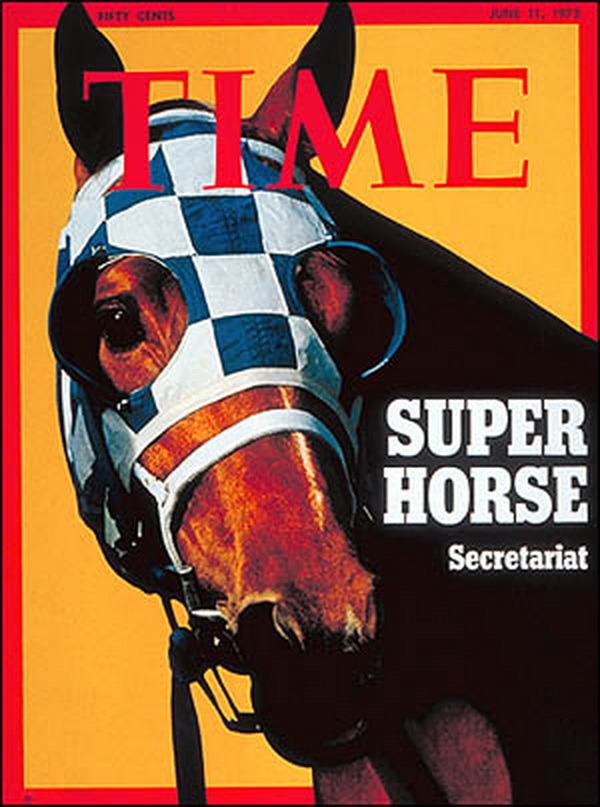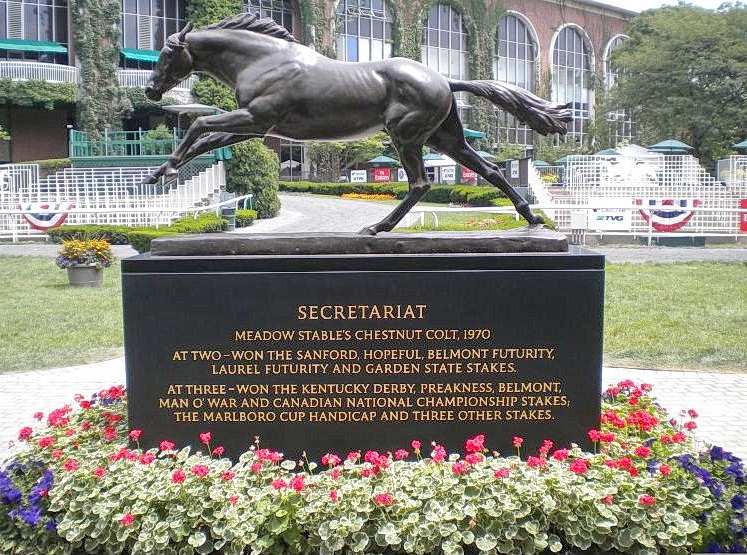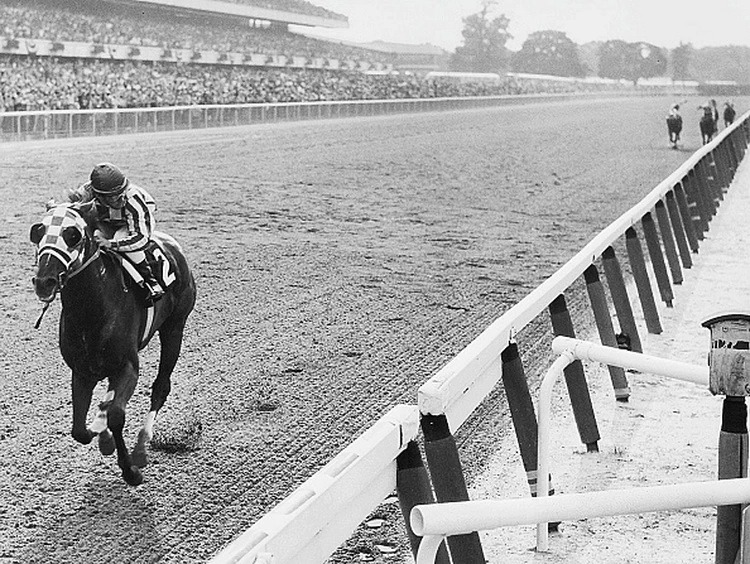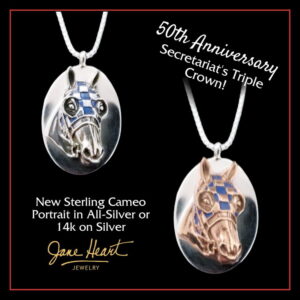The biggest assignment of my fledgling sports writing career put me at Belmont Park on June 9, 1973, shadowing Penny Chenery Tweedy, the powerful chestnut’s patrician owner. I wrote what is known as a sidebar; not the main story about the most historic Belmont Stakes, but rather, a piece cataloguing the reactions of the horse’s inner circle.
With the Belmont on the docket again for this weekend, I will remember once more being in the corner of a historic occasion.
At the start of that special day a half-century ago, I hung out with a few dozen other members of the media by the barn where Secretariat was stabled, happily aware of the great privilege my newly bestowed press pass imparted.
My initial in-person glimpse of Secretariat was fulfillment, an opportunity to witness radiant greatness first-hand. His presence was far more powerful than it had been on television, where I first made his acquaintance. You’ve read the adjectives; they all apply, from the striking color of his coat to his rippling musculature and look of confidence. He definitely knew who he was, and we all paid homage.
Even the veteran racing writers, a skeptical group if there ever was one, showed respect, and dare I mention it — a touch of awe.
When the time arrived for the walk to the paddock, I became part of the parade, buoyed by the feeling — growing every minute — that something far beyond a mere horse race was about to happen. There was just one question hanging over the proceedings: Could Secretariat win the Triple Crown, the prize that had eluded every great horse since Citation swept it 25 years before in 1948?
While he had the ability, of course, there was always fate, that unsportsmanlike spoiler hanging around. Secretariat seemed a sure thing, but this was horse racing and who knew what could happen? From the starting gate to the finish line, there were too many possibilities for scuttling a dream, no matter what the 1-10 odds on the tote board indicated.
I was wearing a distinctive black and white polka dot dress that day. The wardrobe choice turned out to be fortunate, enabling me to spot myself over the years in photos and videos of the march to destiny by Sec (as headline writers called him) and his entourage.
The tree-shaded paddock at Belmont, where Secretariat’s statue now stands, is at once grand and intimate. The horses are close for a turn or two after being saddled before stepping out onto the track. In those days, the race’s theme song was “The Sidewalks of New York,” (it was replaced in 1997 by “New York, New York). It struck a chord that was stronger in me than the anthems of the previous two Triple Crown races, the Kentucky Derby’s “My Old Kentucky Home” and “Maryland, My Maryland” for the Preakness.
This was it, the big moment. How big it would be, I never guessed and I doubt that anyone else did, either. It seemed almost certain that Secretariat would win. But none of us could have figured by how much, or the way the memories of that day would gain ever-more traction as the years slipped by.

Penny Tweedy and trainer Lucien Laurin are center and right in the front row. I am in the second row, second from left, with sunglasses and that polka dot dress.
I wish I had each of those minutes back, so I could polish and appreciate them properly. They were a once-in-a-lifetime opportunity not only to see history, but also to be a tiny part of it.
I stuck close to Penny Tweedy (she would later divorce and go back to using her maiden name). The elegant Meadow Stable owner had an aristocratic demeanor that would have been intimidating in anyone else, but she was down-to-earth and wonderfully polite, considering the gravity of the occasion.
Nothing would get between me and my quarry. Football linebackers were my inspiration as I turned aside interlopers while following her to the box from which she would view the race. She was grace; I was determination.
I had yet to develop the tactful hovering technique eventually perfected for other horse races as the years went by, when I wrote the sidebars on other owners. Eventually, I came up with a way to remain on the fringes without being too obvious, yet close enough to eavesdrop when necessary for “color” and quotes.
My demeanor with Mrs. Tweedy (I still tend to call her that) combined respectful and persistent. She was quite patient with me, giving thought to all my questions, despite the fact that they were similar to queries she’d answered dozens of times along the path of Secretariat’s many triumphs. She was rather more forthcoming than I expected someone of her standing to be, but there was no way to approach her other than with the regard she deserved.
Mrs. Tweedy had been in the spotlight before, albeit one not of the intensity that Secretariat commanded. Her less glamorous Riva Ridge won the Derby and Belmont the previous year, missing out on the Preakness when the track came up muddy and not to his liking.
I, however, had no experience with an occasion at the level of importance enjoyed by the 1973 Belmont. I had not even been to the track on the edge of New York City previously, nor had I ever seen a race of this caliber anywhere but on TV. For me, it was like going from zero to 60 in a few seconds of elevation to the big time.
It was a thrill to see Secretariat in Meadow’s distinctive blue and white silks with his trademark checkered blinker hood, colors and a pattern that would become a part of history. As the great horse headed to the starting gate with Ron Turcotte aboard, I don’t think I was breathing.
My gaze flicked between the horse and his owner, a marvel of self-control, though I would think her butterflies outnumbered mine exponentially. Earlier in the year, she had syndicated Secretariat for a record $6.08 million, and I’m sure those who had bought shares were expecting a lot for their money. They got it, and more.
The race began with an “And they’re off!” roar from the crowd as the field of five broke. Sham, the Triple Crown perennial second banana, challenged Sec’s lead, but couldn’t keep up and would eventually finish a discouraged last. As Big Red pulled away from his non-rivals, I forgot my mission and stopped watching Mrs. Tweedy, focusing only on the colt who had become a galloping machine.
To some, it may have looked as if he were running off, but the more knowledgeable realized that his jockey was simply allowing him do his thing. The crowd’s noise increased with every stride, coming to a crescendo like the sound of 1,000 freight trains. We all were one, all of us, joined in total adoration and admiration as Secretariat galloped toward the finish line to put an exclamation point on his performance.
He set a record with his 31-length victory in 2:24 for the mile and a half. The big horse also had set a record in the Kentucky Derby, but due to a clock problem in the Preakness, the fact that he had set a record in that race was not confirmed until 2012.
Mrs. Tweedy was delighted with the victory but quickly regained her composure after initial moments of jubilation. Someone with less class would have been freaking out, but that wasn’t her style.
As she went to the winner’s circle, I stood in silence for a moment before I was able to refocus, then headed off to write my story; a different reporter was assigned to the press conference. My brush with history was over, but it never would be forgotten.
Although it had been quite an afternoon, the excitement amplified over the years as Secretariat’s legend grew and I appreciated even more what I had witnessed firsthand and in very special company.
I went on to cover the subsequent triple crowns of Seattle Slew (1977) and Affirmed (1978), yet they weren’t the same. When Affirmed won, it actually seemed as if the Triple had become routine in a sense. But the fact that the next Triple winner, American Pharaoh, didn’t wear the crown until 37 years after Affirmed, underlined the difficulty involved in the achievement. That was a longer stretch than the gap between Citation and Secretariat. And then Justify did it three years later, in 2015, but we’re still waiting for the next one.
Of course, we won’t see it this year. The Kentucky Derby winner, Mage, was third in the Preakness and is not even running in the Belmont.
There is no question that the Triple Crown is a stupendous achievement; any horse topping the Kentucky Derby, the Preakness and the Belmont over the space of five weeks is worthy of accolades. There is talk of spreading out the test, keeping the Derby in May, moving the Preakness to June and having the Belmont in July. It wouldn’t be the same, but what is these days?
On another racing occasion a few years after Sec’s Triple Crown triumph, I ran into Mrs. Tweedy again and threw her a question to which I thought I knew the answer.
“Who was your favorite horse?” I asked, sure that she would say “Secretariat.” How could she not respond that way; he was everybody’s favorite horse.
Instead, she replied, “Riva Ridge,” explaining that it was because his 1972 victories had helped save her family’s Meadow Stable by averting the sale of the financially troubled farm.
For me, however, and for millions, there is only Secretariat. He was the Man O’ War of our age, and I was incredibly privileged to be present for this king’s coronation.
Like me, so many people have cherished memories of Secretariat that are surfacing as we mark the 50th anniversary of his historic Triple Crown.
One of those with a special connection to the magnificent chestnut is Jane Heart, a jewelry designer known for her work that represents a breed or discipline with artistic accuracy.
Through the years, she had never done a design paying tribute to a famous horse until she learned that Gretchen and Roy Jackson, the breeder-owners of Barbaro, were starting a fund for laminitis research in his memory.
Barbaro, who won the 2006 Kentucky Derby, shattered his right hind fetlock two weeks later in the Preakness. Everything possible was done to save him, but he contracted laminitis and had to be euthanized.
When Jane’s husband saw an article about Barbaro and mentioned it to his wife, Jane was intrigued. She contacted Gretchen Jackson seeking a license to design jewelry with Barbaro’s likeness that would benefit the fund.
After her success with Barbaro, Jane’s desire to continue honoring specific horses led her to Secretariat, the stallion she calls “the greatest horse who ever lived.”
Connecting with his people was not easy, however. It took two years to get an approval from Secretariat’s owner, Penny Chenery. But Jane was persistent. Jane finally got together with Penny, who had to approve everything that was licensed and used his trademark name.
“She was so sharp and noticed every little detail,” Jane recalled.
“Nothing missed her sharp eye. I remember we were doing an event in Doswell, Va., in a bookstore. I walked past her and she quipped…”Jane…love your patent leather tennis shoes!”
“I so admired her and her story so very much,” said Jane, adding, “What an inspiration to women!”`

The Time magazine cover that inspired Jane Heart’s Secretariat pendant.
Jane recalled fondly, “Over the years, I was able to see her many times doing trunk shows with the jewelry at the Secretariat Festivals in Paris, Ky., several Vox Populi awards at Santa Anita and events at Belmont Park.”
Jane enjoyed a role as an extra in the 2010 movie, “Secretariat,” and even got to ride with Seretariat’s jockey, Ron Turcotte, and his family in the disabled jockey’s special van during a Belmont Stakes event. Every time Jane had something new to show Penny, she would approve it.
“I am honored to have the license to design jewelry for Secretariat,” said Jane, who has come out with a special design in honor of Big Red’s victory in the 1973 Belmont Stakes to clinch the Triple Crown.
The new cameo necklace with great dimension is stamped with his name on the back and comes with a special anniversary card. It is cast in sterling silver with a hand-cut sterling disc. There also is a 14-karat gold head version on sterling in a limited edition of 50, as seen on the right.
The image is enhanced by a hand-enameled version of his familiar blue-and-white-checked blinkers in the colors of Meadow Stable as he looks toward the camera, the way he loved to do.
Click on this link to Jane’s website to see more about her special design for the anniversary of Secretariat’s Belmont. A portion of the proceeds will go to the Secretariat Foundation.
As Jane noted, “I am honored to have the license to design jewelry for Secretariat. He, indeed, followed his heart with his tremendous passion for running and has been an inspiration to me to continue to follow my own heart.”
She hopes those who buy the necklace likewise will be inspired to pursue their dreams and reach the highest level of their ability.






